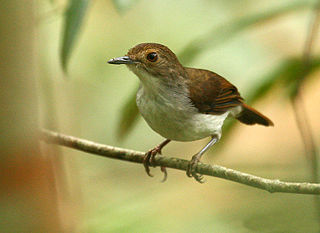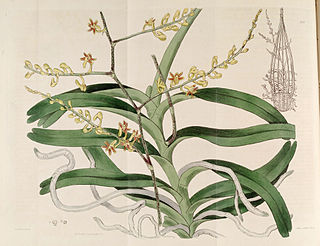
Setosphaeria rostrata is a heat tolerant fungus with an asexual reproductive form (anamorph) known as Exserohilum rostratum. This fungus is a common plant pathogen, causing leaf spots as well as crown rot and root rot in grasses. It is also found in soils and on textiles in subtropical and tropical regions. Exserohilum rostratum is one of the 35 Exserohilum species implicated uncommonly as opportunistic pathogens of humans where it is an etiologic agent of sinusitis, keratitis, skin lesions and an often fatal meningoencephalitis. Infections caused by this species are most often seen in regions with hot climates like Israel, India and the southern USA.
Erucastrum rostratum is a species of flowering plant in the family Brassicaceae. It is found only in Yemen. Its natural habitat is rocky areas.

The white-chested babbler is found in Brunei, Indonesia, Malaysia, Myanmar, Singapore, and Thailand. Its natural habitats are subtropical or tropical moist lowland forests and subtropical or tropical mangrove forests. It is threatened by habitat loss.
Aulonocara rostratum is a species of haplochromine cichlid. It is endemic to Lake Malawi where it is found in Malawi and Tanzania. It is found throughout the lake. The males gather in loose aggregations in sandy areas, defending small territories which they defend from other males.
Memecylon rostratum is a species of plant in the family Melastomataceae. It is endemic to Sri Lanka.
Psidium rostratum is a species of tree in the family Myrtaceae. It is endemic to Peru and considered as a vulnerable species by the IUCN. This species can attain a height of 10 meters.

Cleisostoma is a genus of orchids with approximately 90 accepted species widely distributed through much of the Indian Subcontinent, Southeast Asia, China, New Guinea, and some of the islands of the Western Pacific.
Zebrasoma rostratum, the longnose surgeonfish or black tang, is a marine reef tang in the fish family Acanthuridae. They may live at water depths of 10–61 m (33–200 ft) or more. The fish grow to a maximum length of 21 cm (8.3 in). Zebrasoma rostratum is found in the South Pacific off the coasts of the Society Islands, Marquesas Islands, Line Islands, Tuamoto Islands to the Pitcairn Islands.

Solanum rostratum is a species of nightshade that is native to the United States and northern and central Mexico. Common names include buffalobur nightshade, buffalo-bur, spiny nightshade, Colorado bur, Kansas thistle, bad woman, Mexican thistle, and Texas thistle.

Rostratus (masculine), rostrata (feminine) or rostratum (neuter) is a Latin adjective meaning "beaked, curved, hooked, with a crooked point, or with a curved front".

Cleisostoma paniculatum is a species of orchid found in India, Assam, Bhutan, Taiwan, Thailand, Vietnam, and China.
Cleisostoma recurvum is a species of orchid found in Cambodia, Laos, Thailand, Vietnam and China.

Cleisostoma simondii is a flowering plant that grows upon larger trees, and known in Hong Kong as (Chinese:蜘蛛蘭). It also occurs in the Himalayas, Cambodia, Laos, Myanmar, Thailand, Vietnam, and other parts of China.
Schistotylus purpuratus, commonly known as purple sprites, is the only species in the genus Schistotylus from the orchid family, Orchidaceae. It is a small epiphytic orchid with up to six crowded, linear leaves and up to ten cup-shaped, pale green flowers with purple marking and a mostly white labellum. It grows in rainforest and swampy heath in eastern Australia.
Palaquium rostratum is a tree in the family Sapotaceae. The specific epithet rostratum means "beaked", likely referring to the fruit.

Erythronium rostratum, the yellow fawnlily or golden-star, is a plant species native to the south-central part of the United States.
Cleisostoma williamsoni is a species of orchid. It is found in Asia.
Macrostomum rostratum is a free-living, hermaphroditic flatworm in the family Macrostomidae, found in freshwater and brackish environments.

Cleisostoma crochetii is a species of orchid found in Vietnam, Cambodia and Laos.

Cleisostoma sagittatum is a species of orchid found in Borneo, Java, the Philippines and Sumatra. This species was first described by Blume in 1825.









